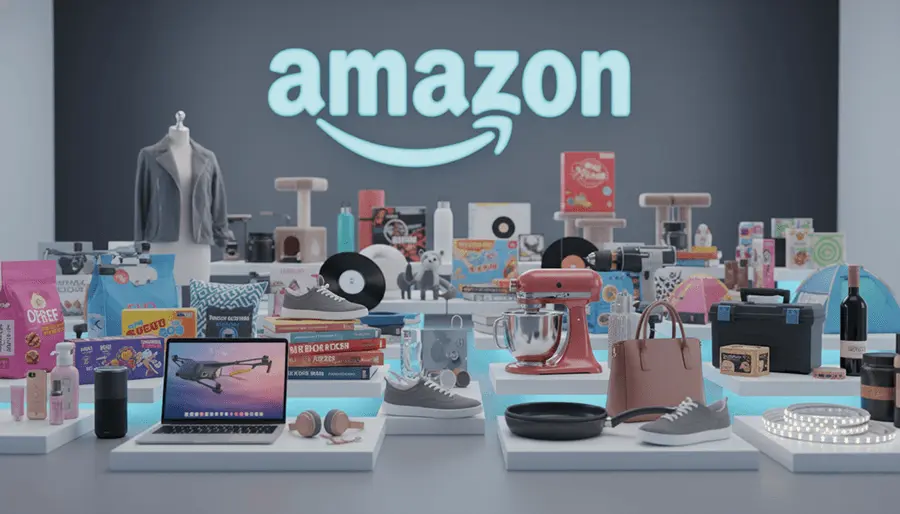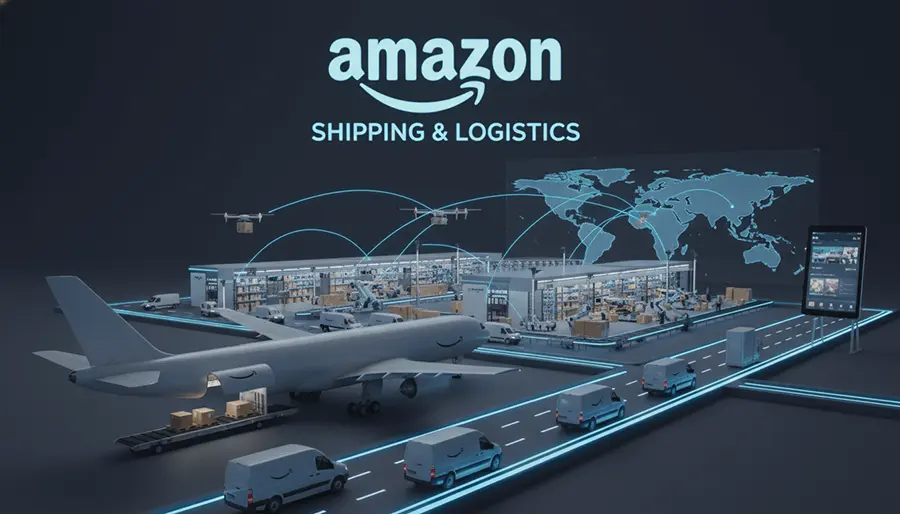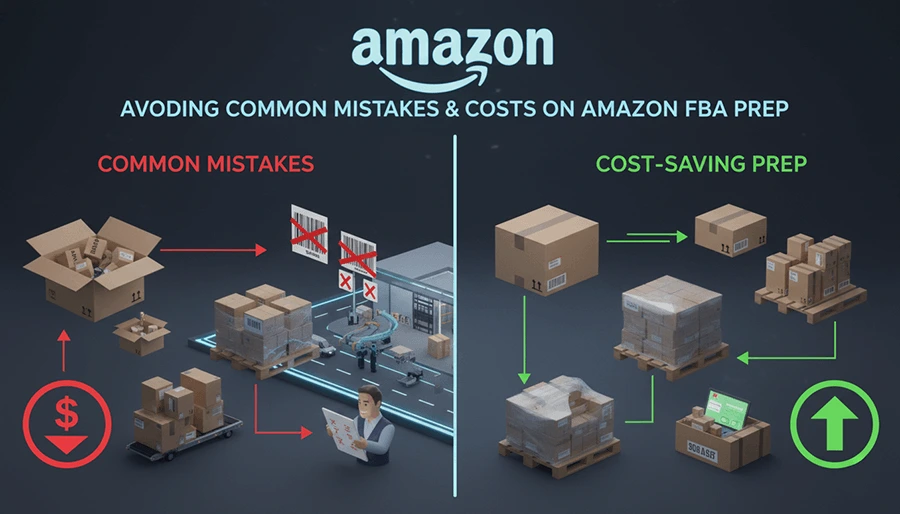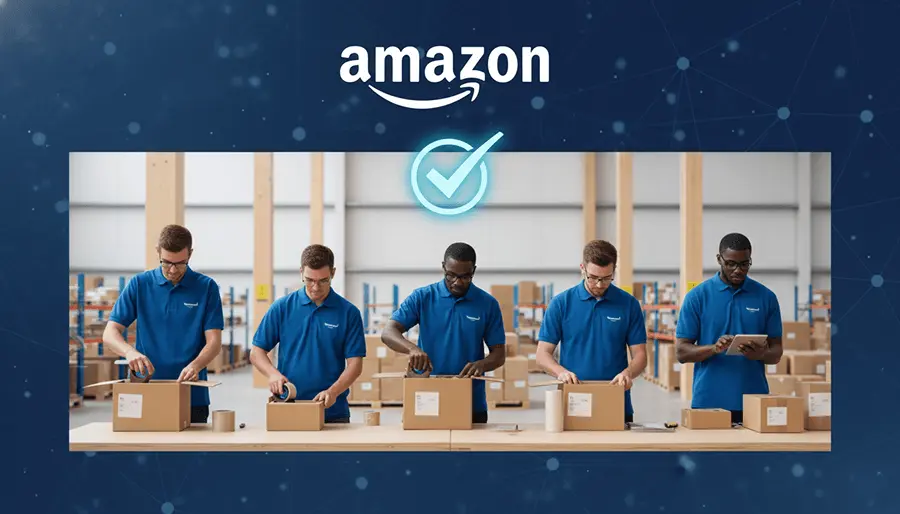TABLE OF CONTENTS
- Create your shipment plan
- Prepare and label your products
- Pack boxes according to FBA standards
- Print and apply labels
- Select your shipping method
- Confirm and track your shipment
Mastering Product-Specific Prep
Apparel, Fabric, and Plush Items
Shipping Carton & Pallet Requirements
Small Parcel vs. LTL/FTL Shipments
Avoiding Common Mistakes & Costs
The Definitive FBA Prep Checklist
- Product Inspection and Condition
- Unit Preparation and Packaging
- Barcoding and Labelling
- Box Packaging and Shipment
- Shipment Labeling
- Documentation and Tracking
- Final Verification
- What is the weight limit for an Amazon FBA box?
- Can you reuse boxes for FBA shipments?
- What kind of tape should you use?
- Do you need to label every product in an FBA shipment?
- Where do you find your FBA Shipment ID?
- What happens if your shipment doesn’t meet prep standards?
- Can you mix different SKUs in one box?
- How do you calculate Amazon FBA storage fees?
If you plan to grow your business through Amazon FBA (Fulfillment by Amazon), preparation matters more than you might think.
Before any box reaches an Amazon fulfillment center, it has to meet specific standards for packaging, labelling, and documentation. These Amazon FBA prep requirements exist to keep warehouses running efficiently and to make sure your inventory arrives in perfect condition.
Ignoring those details can lead to delays, additional fees, and product damage, ultimately cutting into your profit margin. Understanding how to prepare and ship correctly keeps your products moving and your customers happy.
In this guide, we’ll outline the exact Amazon FBA prep requirements every seller should follow before shipping inventory. As you read, you’d learn:
- The foundations of FBA prep
- How to navigate shipping and logistics
- How to master product-specific prep
- How to avoid common mistakes and costs
- Packaging materials and specifications
- The definitive FBA Prep checklist
Let’s get right in.
The Foundations of FBA Prep

Amazon FBA (Fulfillment by Amazon) allows you to store your products in Amazon’s warehouses while they handle storage, packing, and delivery.
Every product that enters the warehouse system should be packaged, labelled, and documented the same way. This keeps warehouse operations efficient and reduces the risk of delays or damaged inventory.
Here are the essential elements of proper preparation:
- Packaging: Use sturdy, durable materials that can handle stacking and transport
- Labelling: Each unit needs a scannable FNSKU or UPC barcode, clearly placed on a flat, visible surface
- Box Limits: Keep cartons under 50 lbs (22.68 kg) and within the Amazon FBA box size limit (no side longer than 36 inches (36" L × 25" W × 25" H)
- Documentation: Every shipment must include a valid FBA Shipment ID label and carrier label that match your Seller Central shipment plan
When you meet these standards, your inventory flows smoothly from your warehouse to Amazon’s, and eventually to the customer, without interruption.
If your products arrive mislabeled, poorly packed, or missing documentation, Amazon’s receiving team will stop the process immediately. This results in additional FBA fees, delayed inventory check-ins, and occasionally, the return or disposal of entire shipments.
Proper prep saves you time, money, and reputation. It also:
- Enables faster processing
- Lower costs
- Ensures fewer returns
- Ensures compliance protection
To simplify the prepping process, Amazon has streamlined its inbound shipping setup through the Send to Amazon workflow in Seller Central. This process guides you from product selection to final shipment confirmation.
Here’s what the process looks like:
1. Create your shipment plan
Select the products you’re sending, enter the quantities, and confirm the destination marketplace. Amazon automatically assigns fulfillment centers based on demand and location
2. Prepare and label your products
Package and label each unit according to the Amazon FBA prep requirements. If you’re using FNSKU barcodes, make sure they’re printed clearly and placed for easy scanning
3. Pack boxes according to FBA standards
Keep boxes under 50 lbs and within size limits. Use strong tape and seal securely
4. Print and apply labels
Attach both the FBA Shipment ID label and the carrier shipping label on the top surface of each carton. Make sure labels aren’t placed over seams or tape
5. Select your shipping method
Choose between Small Parcel Delivery (SPD) for smaller shipments or LTL/FTL for palletized freight. Partner carriers within Seller Central also offer discounted rates
6. Confirm and track your shipment
Once your boxes are picked up, upload tracking details in Seller Central. You can monitor the progress until the inventory status updates to “Receiving” or “Available”
A well-organized shipment can be checked in and available for sale within days. However, poorly prepped boxes can sit in holding areas for weeks.
Mastering Product-Specific Prep

Amazon categorizes items by material type, fragility, and packaging needs, and each category comes with its own rules.
Below are the main product types and how to prep them correctly before sending to FBA.
Loose Products
Any item that isn’t sealed or boxed should be placed in a polybag or individual carton. This prevents units from separating or spilling during transit. For example, small accessories or cables should be bagged together with the SKU label visible on the outside.
Boxed Units
If your products come in boxes, they must be sealed and able to pass a simple drop test, without breaking or exposing contents. Boxes should not collapse or open when stacked. Use new, undamaged cardboard and strong tape on all seams.
Sold as a Set
If your products are intended to be sold together (for example, a skincare bundle or a set of utensils), each package must display a visible label that reads “Sold as Set – Do Not Separate.” Without this, Amazon’s warehouse staff may unpack and treat them as separate items.
Fragile Products
Glassware, ceramics, electronics, and similar goods require individual wrapping. Use bubble wrap or foam padding to protect every surface, and ensure the item can survive a short drop without breaking. Add a “Fragile” label so handlers know to take care.
Liquids
Liquid items need extra protection to avoid leakage. Seal the caps tightly, add an inner protective seal if possible, and place the product in a clear polybag. This prevents spills that could damage other inventory in the shipment.
Apparel, Fabric, and Plush Items
Soft goods like clothing, textiles, and plush toys should be placed in clear, resealable polybags to protect against dust and moisture. If the bag’s opening is larger than five inches, it must display a suffocation warning in legible print.
Sharp or Pointed Items
Products with blades, tips, or pointed edges must be safely enclosed so nothing pierces the packaging. Knives, scissors, or metal tools should include plastic blade guards or cardboard sleeves.
Perishable and Dated Products
Perishables are not allowed in FBA unless they are shelf-stable. Products with expiration dates, like vitamins or cosmetics, must have at least 90 days of shelf life remaining at check-in. Print the expiration date clearly on both the product and the outer packaging.
Consistent product-specific prep prevents loss, improves handling time, and shows Amazon that your operation is reliable and compliant, which matters when scaling your FBA business.
Shipping & Logistics

Once your products are properly prepped, the next step is packing and shipping them in compliance with Amazon’s inbound standards.
Shipping Carton & Pallet Requirements
- Weight Limit: Each box should weigh no more than 50 lbs. If an item itself exceeds that weight, label the box “Team Lift”
- Size Limit: No side of the box should exceed 36 inches (36" L × 25" W × 25" H)
- Pallets: For shipping palletized inventory, use standard 40" × 48" pallets, with a maximum size of 72 inches per pallet. Also, the total weight must not be more than 1500 pounds
Make sure each carton is strong enough to support stacking. Lightweight boxes tend to collapse under warehouse pressure, leading to damage and slower processing times.
Labeling Requirements
Every box must carry two types of labels:
1. FBA Shipment ID label, which should be generated in Seller Central when you create your shipment
2. Carrier label, which should be generated from your chosen shipping service (UPS, FedEx, etc)
Apply both labels on a flat surface, preferably the top of the box. Avoid placing them over seams or tape to make sure scanners have a clear view.
If you’re shipping pallets, place labels on all four sides for easy scanning at the fulfillment center.
Small Parcel vs. LTL/FTL Shipments
Amazon accepts two primary shipment methods:
- Small Parcel Delivery (SPD): Ideal for smaller shipments or mixed SKUs. Each box ships individually and carries its own tracking number. Amazon also offers discounted rates through its partnered carrier program (usually UPS)
- Less Than Truckload (LTL) or Full Truckload (FTL): Best for large-volume or palletized shipments. LTL is more cost-efficient for bulk inventory and provides consolidated tracking. You’ll need to schedule freight pickup and provide pallet count and dimensions
You can choose between SPD and LTL depending on shipment volume, weight, and delivery speed. Many Amazon sellers begin with SPD and transition to LTL as their operations scale to regular pallet loads.
Documentation and Tracking
Every shipment created in Seller Central comes with a shipment ID. Keep this ID on file and cross-check it with your carrier’s tracking numbers.
Upload tracking details in Seller Central once the boxes are in transit. This helps Amazon prepare for receipt and reduces check-in times.
Avoiding Common Mistakes & Costs

The most common prep mistakes usually come from rushing, assuming suppliers handled the prep correctly, or not checking Amazon’s updated policies before shipping. Paying attention to these tiny details can save you hundreds in unnecessary FBA fees and weeks of delay.
More of these common mistakes include:
Skipping Label Checks
Every unit needs a scannable FNSKU that matches the listing in Seller Central. When you place your labels on curved edges or over seams, they fail during scanning. Always apply your barcodes to flat, clean surfaces and confirm that old manufacturer barcodes are completely covered
Mixing SKUs in One Box
Combining multiple SKUs in the same box without clear separation or labelling slows down Amazon’s receiving process. Use dividers or smaller inner cartons if you need to combine items, and clearly list the contents in your shipment plan
Overweight or Oversized Boxes
Anything over 50 lbs requires a “Team Lift” label, and any box with a side longer than 36 inches (36" L × 25" W × 25" H). Sending boxes that exceed these limits may result in re-pack fees or shipments being refused
Weak or Reused Cartons
Reusing boxes from previous shipments might seem cost-effective, but it can backfire. Cartons that are already creased or soft will collapse during transit. So, always use new, single- or double-wall corrugated boxes that can withstand stacking
Missing Polybag Warnings
Bags larger than five inches across must have a printed suffocation warning. It’s a small detail, but Amazon will stop the shipment if it’s missing. Suppliers sometimes overlook this, so check the packaging before labelling
Ignoring Expiration Dates
Products such as supplements, cosmetics, or food must have at least 90 days of shelf life remaining. These dates need to be printed in a clear, readable format. Failing to include or properly format the expiration dates will lead to the stock being marked as unsellable.
We recommend taking five minutes to double-check barcodes, weight, and labels. It’s faster than dealing with an FBA suspension later.
The Definitive FBA Prep Checklist

Before sending any shipment to Amazon, it’s worth running through a detailed prep checklist. A final five-minute review can save you days of delay and prevent unexpected fees.
Use the following list to confirm that your products and packaging meet all FBA requirements.
1. Product Inspection and Condition
- Inspect every item for scratches, leaks, or manufacturing defects
- Remove dust, price tags, or residue from packaging
- Confirm that all units are new; used or refurbished items are not accepted under FBA unless specifically listed as such
- For dated goods, check that at least 90 days of shelf life remain and that the expiration date is printed clearly on both the item and outer packaging
2. Unit Preparation and Packaging
- Package each item based on its category (polybag, box, or bubble wrap)
- Seal liquid products with both an inner cap and an outer polybag
- Wrap fragile products individually using bubble wrap or foam
- Add “Fragile” or “This Way Up” labels where relevant
- Ensure apparel or plush items are in clear, sealed polybags with suffocation warnings
- Apply “Sold as Set – Do Not Separate” labels to any bundled units
3. Barcoding and Labelling
- Print FNSKU labels from Seller Central and attach one to every sellable unit
- Place labels on flat, clean surfaces, not seams, corners, or curved areas
- Cover or remove old barcodes to prevent scanning errors
- For products in opaque packaging, make sure the barcode remains visible once sealed
- If you use manufacturer barcodes (UPC), confirm that your listing allows for “stickerless commingled inventory.” Otherwise, FNSKU labels are mandatory
4. Box Packaging and Shipment
- Keep each box under 50 lbs unless marked “Team Lift”
- Use strong, new corrugated boxes with secure “H” taping
- Avoid mixing different SKUs in one box unless divided and clearly labelled
- Fill empty spaces with air pillows, foam, or kraft paper to prevent movement
- Conduct a quick shake test; if items shift audibly, add more padding
5. Shipment Labeling
- Print both the FBA Shipment ID and the carrier labels directly from Seller Central
- Place both labels on the same side, preferably the top of the box
- Leave at least one inch of clearance around label edges
- Double-check that the shipment ID matches your plan before sealing the carton
- If shipping pallets, label all four sides
6. Documentation and Tracking
- Verify shipment details in Seller Central after pickup
- Keep a copy of tracking numbers for each box or pallet
- Watch for updates under “Receiving” until the status changes to “Available”
- If a shipment shows “Delayed” or “Missing Units,” open a case promptly with Seller Support, including your tracking proof
7. Final Verification
- Review your invoice or packing slip for SKU accuracy
- Count your boxes before handing them to the carrier
- Take a quick photo of each labelled box for recordkeeping, this is especially useful if Amazon later reports missing inventory
- A consistent checklist ensures every shipment meets expectations and reduces risk as your operation scales
FAQs
- What is the weight limit for an Amazon FBA box?
Each box can weigh up to 50 lbs. Any heavier carton must be labelled “Team Lift.” Oversized single products may exceed this limit only when shipped alone and properly documented.
- Can you reuse boxes for FBA shipments?
Yes, but only if they’re in excellent condition. Boxes with dents, tape residue, or prior branding can lead to damage or rejection. Always remove old labels before reuse.
- What kind of tape should you use?
Use pressure-sensitive shipping tape that’s at least 2 inches wide. Clear or kraft tape is acceptable. Avoid using masking, duct, or painter’s tape, as they can loosen during transit and fail warehouse drop tests.
- Do you need to label every product in an FBA shipment?
Yes. Every unit requires its own scannable barcode (FNSKU) unless your account is set up for stickerless commingled inventory. Labelling ensures Amazon attributes the product correctly to your account.
- Where do you find your FBA Shipment ID?
You can find it in Seller Central under Send to Amazon → Review Shipments. Download the labels directly from that page. Each label includes the shipment ID and destination code for tracking.
- What happens if your shipment doesn’t meet prep standards?
Amazon may charge for unplanned prep, delay check-in, or return the shipment. Repeated violations can lead to performance warnings or restricted inbound shipping privileges.
- Can you mix different SKUs in one box?
Yes, but only if they are listed together in your shipment plan and clearly separated or bagged. Mixing without organization causes confusion during receiving and may result in delays.
- How do you calculate Amazon FBA storage fees?
Storage fees depend on cubic footage, season, and the time inventory stays in fulfillment centers. Oversized boxes or incorrect packaging can increase these fees by reducing space efficiency.






.svg)

.avif)

.svg)